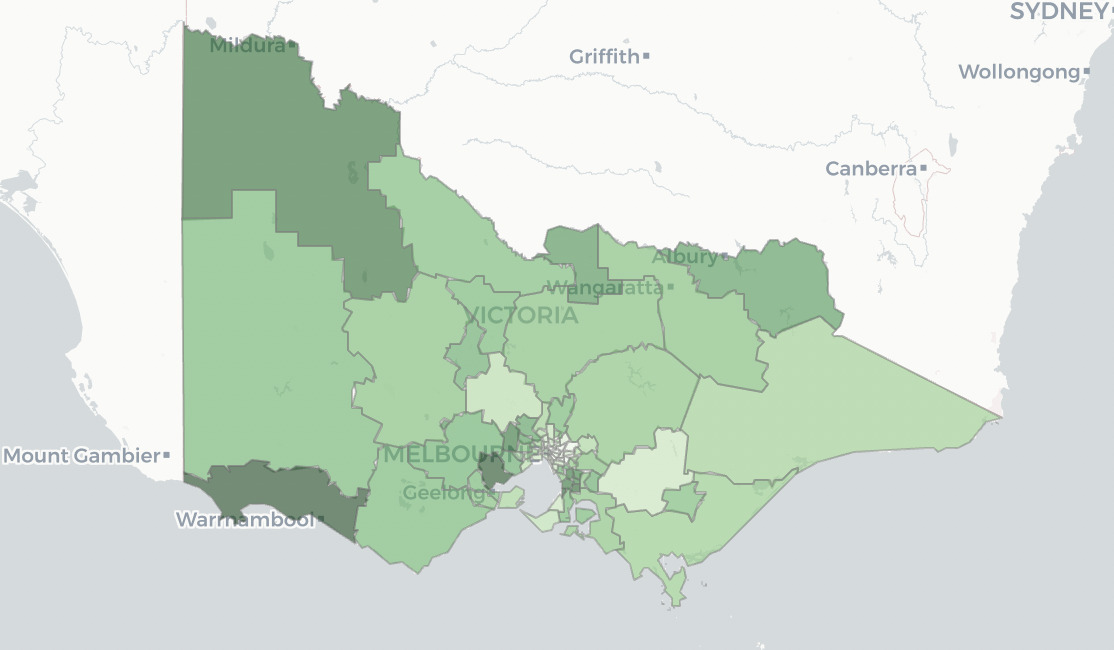In the weeks after the Victorian election, I saw some analysis looking at the geographic patterns of support for some of the parties. One of the things I was most interested in identifying was the relationship between informal voting trends and support for particular parties.
There’s a lot of explanations for informal voting trends – literacy and understanding of the voting system, errors in casting a ballot, and disillusionment with politics. Yesterday’s blog post contained a map showing the relative rates in the Assembly informal rate. For this blog post I’ll be analysing results for the Legislative Council, but the two numbers move closely together – the correlation is about 0.84. While voter error is less of an issue with the upper house, the other causes of informality remain an issue.
It makes more sense to perform this analysis on the upper house due to the consistency of parties contesting each seat. Only a handful of larger parties ran in most lower house seats, but every party contested every upper house region, so you get a better comparison.
I had originally been interested in the pattern of support for Legalise Cannabis, and I will return to them, but I started by running correlations at the booth level for each party compared to the informal rate. I also lumped together the combined vote for all of the parties in the Glenn Druery minor parties alliance and ran a correlation on that statistic.
United Australia's vote was most strongly correlated with the informal rate. In other words, their vote tended to be strongest in places with higher informal rates. Family First and the DLP aren't far behind, and the combined vote for the Druery-aligned parties also tends to be strongest in areas with high rates of informality - much more than most of those parties individually.
At the other end, Reason and the Greens have the opposite pattern, with the Coalition not far behind. Their vote tends to be stronger in places with lower rates of informality.
I also made a chart showing the individual data points for the UAP and you can see a pretty clear trend.
The UAP did not rank particularly highly in terms of the total size of their vote, polling just 0.8% and ranking sixteenth amongst the parties.
Three larger minor parties polled over 10% between them: Legalise Cannabis, the Democratic Labour Party and the Liberal Democrats.
Finally, I have produced a map showing the vote by electorate in the upper house for these three parties. The trends are quite interesting.
Legalise Cannabis tended to do best in the outer suburbs - both north-west and south-east. They actually did quite poorly in the sorts of areas where the Greens are strongest - I'm going to return to this in tomorrow's post.
For the DLP and the LDP, you can see some of the regional boundaries quite clearly, where support jumps or falls on either side of the line. These two parties have names that will often be confused with major parties with similar names, and their vote is usually much higher when they have a position to the left of that major party.
The DLP's vote is substantially higher in North Metro, and to a lesser extent West Metro, where they had incumbent MLCs and a good position. The Liberal Democrats do much better in North East Metro and Western Victoria, where they had better ballot positions.
That's it for today - tomorrow, I look at the different voting patterns for the various left minor parties.




Outside of the patterns aligning DLP and LDP to the informal votes, it still appears like there is some further rationale behind their distribution.
For the DLP, it appears they had some of their best support in areas of Melbourne with the highest amount of people identifying as Catholic on the Census. St Albans in particular is one of the highest. This aligns with the base of DLP, which emerged out of historic fractures between Catholics and the Labor Party (amongst other grievances).
Liberal Democrats meanwhile did well in divisions in the Outer-East which are typically mentioned alongside Victoria’s specific strain of libertarianism, commonly associated with the Victorian Liberals.
@ SEQ Oberver, Good point raised. St Albans does have one the highest % of Catholics (27%) as a consequence of large Croatian and Maltese communities. However, the highest is actually neighboring Niddrie which is 44% but DLP got only 2.8% probably as it is much higher socio-economically and the Liberal vote is more significant. Neighbouring, Sydnenham is also quite Catholic at 37% but a lower DLP vote again a more affluent area than St Albans.
Comments are closed.